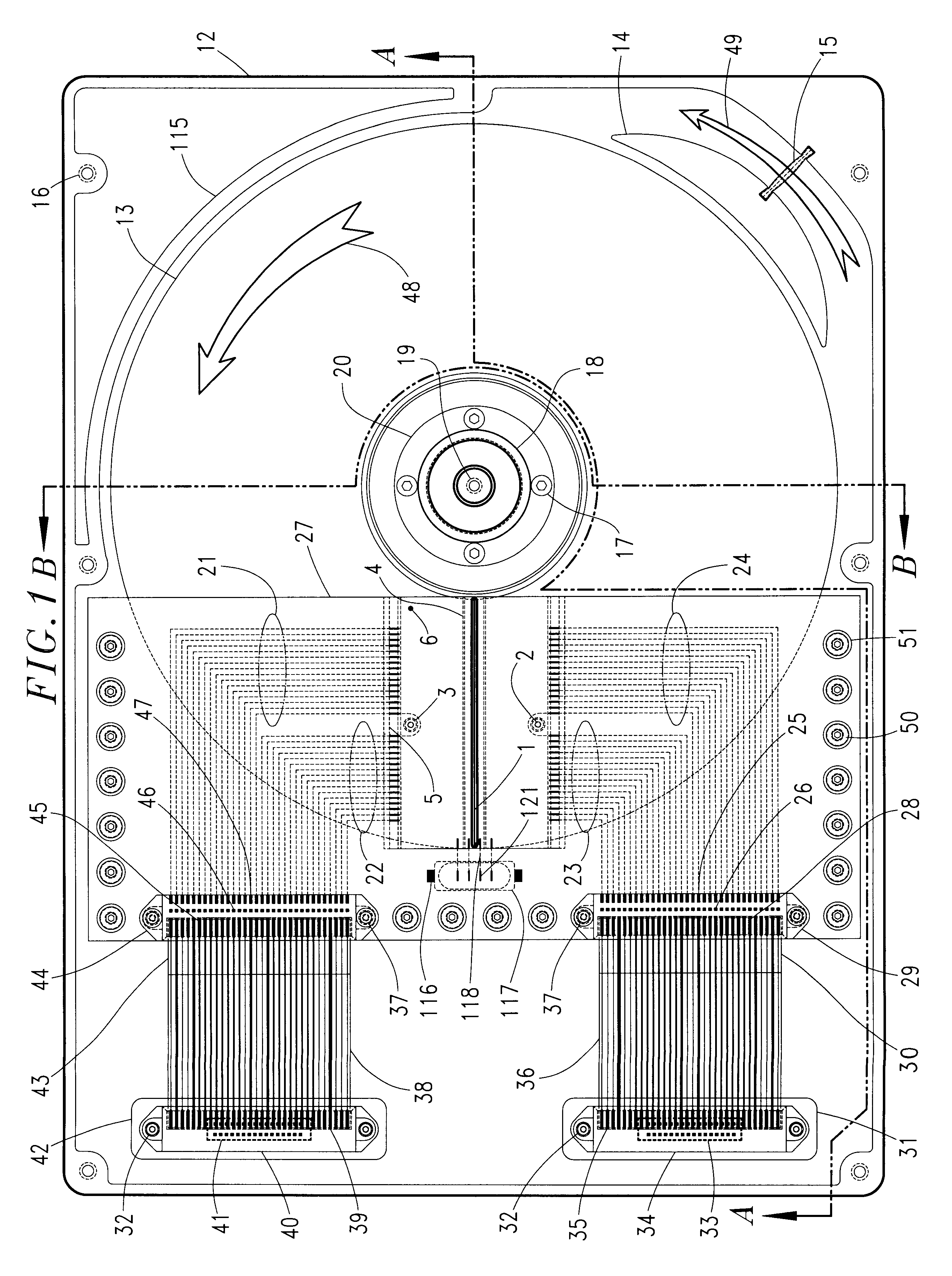Furthermore, another issue confronting the designer of a hard disk drive
system is data-head positioning, and data-
block transfer-rates.
Consequently, when
servo-information is embedded on a data-surface formatted for Zoned-Data-Recording, several complications may arise in the reliably of providing robust
servo-head positioning information.
Typically, if the
servo-information is recorded at the same data-rate and in positional relationship with the recorded data-blocks, as has been conventionally employed in prior art; servo-architecture is normally complex enough to switch data-rates and servo-positions.
However, if regularly spaced servo-information were radially placed across data-storage disk-platter data-surfaces, while splitting some of the data-fields, located on the aforementioned data-surfaces, into segments, data-zones, when crossed-over, could cause serious complications to arise when trying to read each "Split
Data Field" as a single data-block.
Furthermore, the beforementioned disk-platter's rotational velocity must be constantly monitored and carefully maintained at a predetermined
constant angular velocity for the aforesaid "Split
Data Field" scheme to function properly; therefore, adding additional complexity to the servo-
tracking system.
However, some hard disk drive designs do not use, or normally include within their designs, the complication of Zoned Data-Recording and Split Data-Fields.
However, this leads to a tremendous level of
bus-traffic control between a supervisory
microcontroller and a
Disk Controller's Data Sequencer, during a hard disk drive's read-data or write-data disk-operations.
Consequently, the "average seek time" bench-mark ratings for any flying-head (i.e., Magneto-Optical or conventional magnetic) hard disk drive design is easily challenged when using a Magneto-Optical Microhead Array Chip's approach to hard disk drive design.
Furthermore, about "60%" of all conventional flying-head hard disk drive fatal-error crashes are the direct result of rotary voice-coil and / or Spindle-Motor mechanical malfunctions or failures.
When, examining this further, we find that flying-heads, in striving to maintain a designed flying-height distance of "0.5" to "2.5" microns above disk-platter data-surfaces, on what is sometimes called an "air-bearing", the beforementioned flying-heads are therefore never meant to make physical contact with said disk-platter data-surfaces, as they do, during fatal-error hard disk drive crashes, which always results in
data loss.
In fact, within a conventional rotary positioned flying-head hard disk drive design, a head-slider's
flight distance, which is normally "0.5" to "2.5" microns, would be difficult, if not impossible to achieve, were it not for the aerodynamic design of conventional flying-head head-sliders, and the air-bearings that they produce.
Furthermore, fatal-error hard disk drive crashes most often occur when a Spindle-Motor's power supply fails, or the hard disk drive, during a read-data or write-data disk-operation, is suddenly shaken or dropped, while the hard disk drive's head-stack
assembly has not been properly repositioned into an innermost disk-platter area (i.e., sometimes called the head-stack
parking area), but remains located over a data-surface when any of the malfunctions mentioned occurs.
Consequently, during a power-supply failure a hard disk drive's Spindle-Motor will lose its
momentum and begin to spin down; wherein, the head-slider air-bearings will begin to decay, and no longer maintain necessary
aerodynamic lift for the beforementioned head-sliders.
Therefore, a conventional flying-head hard disk drive's head-stack
assembly, not being repositioned into said head-stack
parking area, and being subject too complete loss of head-slider air-bearings, the beforementioned hard disk drive flying-heads will make physical contact with the beforementioned disk-platter data-surfaces; ultimately, crashing into the data-sector areas located on the aforesaid hard disk drive's data-surfaces; moreover, destroying any previously recorded data therein.
Nevertheless, whatever the root-cause might be, the end-result is always the same, hard disk drive crashes and severe data-loss.
However, an increase in the BIMPIC's coil-winding turns has an inherent design-flaw, which occurs in all
induction coil designs, and that flaw is sometimes called "
reactance distortion".
This will, however, also decrease a BIMPIC coils ability to respond to the fast current-reversals that are necessary in an
induction coil data-head design used by today's high-speed data-storage systems.
Furthermore, "
reactance-
distortion" is why conventional high-frequency flying-head designs use no more than five
induction coil coil-winding turns per flying-head yoke-core.
However, the "
reactance-
distortion" that is responsible for poor high-frequency responses within a high-turn induction coil's analog-
signal can now be circumvented.
Furthermore, the beforementioned chip-positioning circuit boards are designed to be very rigid, non-flexible, and lightweight.
Furthermore, the data-transfer frequency-rates determined by data-rate
preamble sync-mark read processes can also be affected by "Spindle Motor" rotational fluctuations; resulting in rotational speed-variances, which could cause read-errors or even data-loss, during a data-transfer disk-operation.
 Login to View More
Login to View More  Login to View More
Login to View More 


